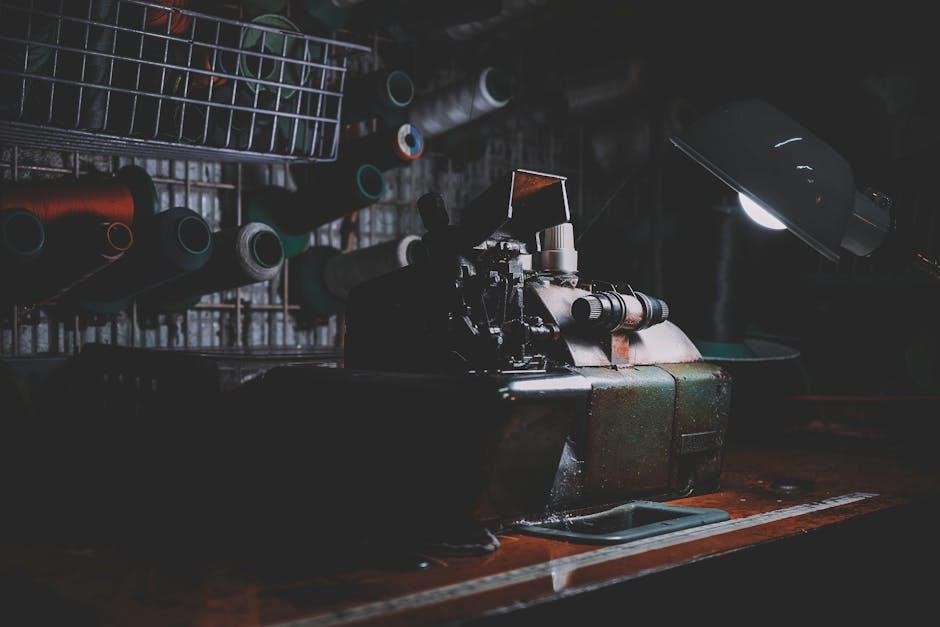The Discovery 1100 Metal Detector Manual is your essential guide to understanding and optimizing your detector’s performance. This comprehensive resource covers key features, setup, operation, and troubleshooting, ensuring you make the most of your metal detecting adventures.
Overview of the Discovery 1100 Metal Detector
The Discovery 1100 Metal Detector is a user-friendly, automated device designed for both beginners and experienced treasure hunters. It features microprocessor-controlled discrimination, enabling precise detection of metal objects while minimizing false signals. With its push-button controls and digital display, the detector simplifies the metal detecting process, making it accessible to all skill levels. The device includes advanced features such as sensitivity adjustments, ground balance, and pinpointing capabilities, ensuring accurate and efficient searches. Its lightweight and durable construction make it ideal for extended use in various environments. Whether you’re searching for coins, relics, or other treasures, the Discovery 1100 provides a reliable and enjoyable metal detecting experience. The detector’s automated functions handle complex settings, allowing users to focus on their hunt rather than adjusting technical parameters. This makes it a versatile tool for anyone looking to explore the world of metal detecting with ease and confidence.
Importance of the Manual for Beginners
The Discovery 1100 Metal Detector Manual is an indispensable resource for beginners, providing clear guidance on how to operate and maintain the device effectively. It explains the fundamentals of metal detecting, such as understanding discrimination settings, adjusting sensitivity, and interpreting audio and visual feedback. The manual also offers troubleshooting tips to resolve common issues, ensuring a smooth learning experience. For newcomers to the hobby, the step-by-step instructions help build confidence and proficiency. By following the manual, users can avoid common mistakes, such as incorrect sensitivity adjustments or improper ground balancing, which might lead to false signals or reduced performance. Additionally, the manual covers essential care and maintenance tips, prolonging the detector’s lifespan. Whether you’re assembling the device, learning basic search techniques, or addressing operational problems, the manual serves as a comprehensive guide to help beginners master the Discovery 1100 and enjoy a rewarding metal detecting journey.

Key Features of the Discovery 1100 Metal Detector
The Discovery 1100 offers advanced features like microprocessor-controlled discrimination, adjustable sensitivity, pinpointing accuracy, and push-button controls. Its robust design ensures reliable performance, making it ideal for both beginners and enthusiasts.
Discrimination Settings and Their Functions
The Discovery 1100 metal detector features advanced discrimination settings designed to help users distinguish between different types of metals. These settings allow the detector to ignore unwanted targets, such as trash or nails, while focusing on valuable items like coins or jewelry. The discrimination function works by analyzing the magnetic properties of detected objects and filtering out non-ferrous metals. Users can adjust the discrimination levels to suit their specific needs, ensuring a more efficient and accurate search experience. This feature is particularly useful in areas with high levels of ground clutter, as it minimizes false signals and enhances the detector’s ability to pinpoint valuable finds. By fine-tuning the discrimination settings, users can optimize their searches and maximize the effectiveness of the Discovery 1100 metal detector in various environments.

Sensitivity Adjustments for Optimal Performance
The sensitivity of the Discovery 1100 metal detector is a crucial setting that determines its ability to detect metal objects. Higher sensitivity increases the detector’s responsiveness, allowing it to pick up smaller or deeper targets. However, excessive sensitivity can lead to false signals or noise, particularly in mineral-rich or highly conductive environments. To optimize performance, users should adjust the sensitivity based on the search conditions.
In clean soils or when searching for small objects, higher sensitivity is beneficial. In areas with heavy mineralization or interference, reducing sensitivity helps eliminate unwanted signals. The detector’s manual provides guidelines for initial sensitivity settings, but practical experience in various environments is key to mastering this adjustment. Fine-tuning sensitivity ensures a balance between detecting desired targets and minimizing false alerts, enhancing the overall metal detecting experience.
Pinpointing Targets with Precision
Precise pinpointing is essential for quickly and accurately locating metal targets with the Discovery 1100. This process involves fine-tuning the detector’s response to isolate the exact location of the object. The manual recommends using the detector’s pinpointing mode, which emits a high-pitched tone when directly over the target. To achieve precise results, users should center the target within the search coil and adjust the coil’s position until the signal is strongest.
The Discovery 1100’s visual and audio feedback aids in pinpointing. The control panel’s meter provides a numerical reading, while the tone changes pitch as the coil approaches the target. For best results, sweep the coil slowly and maintain a consistent height above the ground. This method ensures accurate localization, reducing digging time and effort. Regular practice improves skill in pinpointing, making metal detecting more efficient and enjoyable. The detector’s design simplifies this process, even for beginners, by providing clear and responsive feedback.
Microprocessor-Controlled Discrimination
The Discovery 1100 Metal Detector features advanced microprocessor-controlled discrimination, enabling users to distinguish between different types of metals with high accuracy. This technology analyzes the signal received by the search coil and processes it to identify the target’s conductivity and size. By adjusting the discrimination settings, users can filter out unwanted objects like aluminum cans or bottle caps, focusing only on valuable targets such as coins, jewelry, or relics.
The microprocessor enhances detection efficiency by minimizing false signals and optimizing target identification. It allows for quick and precise adjustments, ensuring a smoother hunting experience. This feature is particularly beneficial in areas with high levels of metal debris, helping users avoid wasting time on non-valuable items. The advanced discrimination system makes the Discovery 1100 versatile for various hunting environments, from beaches to parks, providing reliable performance in diverse conditions. This technology ensures a more enjoyable and productive metal detecting experience for users of all skill levels.

Setting Up the Discovery 1100 Metal Detector
Unpack and verify all components, including the search coil, stem, and control box. Assemble the detector by attaching the coil and adjusting the stem to your preferred height. Perform initial sensitivity and ground balance adjustments for optimal performance.
Assembly and Initial Setup
Begin by carefully unpacking the Discovery 1100 Metal Detector and verifying all components are included. Start by assembling the detector: attach the search coil to the stem and connect it to the control box. Use the provided hardware to secure all parts tightly. Adjust the stem length to a comfortable height using the locking mechanism. Ensure the coil is parallel to the ground for proper operation. Next, perform a visual inspection of all cables and connections to ensure they are undamaged and properly secured. Finally, mount the control box on the stem and tighten it firmly. Double-check that all parts are aligned and balanced before powering on the device. This initial setup ensures stability and accuracy during your first use.
Adjusting the Sensitivity for Different Environments
Adjusting the sensitivity of the Discovery 1100 Metal Detector is crucial for optimizing its performance in various environments. Higher sensitivity settings are ideal for detecting smaller or deeper targets, while lower settings reduce interference in mineral-rich or cluttered areas. Begin by powering on the detector and selecting the “Sensitivity” option on the control panel. Use the “+” or “-” buttons to increase or decrease the sensitivity level. In highly mineralized soil or near metallic debris, lower the sensitivity to minimize false signals. For clean, open spaces like beaches or fields, increase the sensitivity for better depth and accuracy. Always test the detector in the target environment before starting your search. Fine-tuning the sensitivity ensures a more efficient and enjoyable detecting experience, helping you locate treasures while reducing unnecessary noise.
Ground Balance and Its Significance
Ground balance is a critical feature of the Discovery 1100 Metal Detector, enabling it to compensate for mineral content in the soil, which can interfere with detection accuracy. This adjustment ensures the detector distinguishes between mineral deposits and actual metal targets, optimizing performance in diverse environments. To set the ground balance, users typically adjust a specific control while the detector is not near any metal objects, allowing it to calibrate to the ground’s mineral profile. Proper ground balancing minimizes false signals caused by naturally occurring minerals, enhancing the detector’s ability to locate genuine targets effectively. Regular adjustments are necessary when changing search locations, as different terrains have varying mineral compositions. By mastering ground balance, users can maximize the Discovery 1100’s efficiency, ensuring a more productive and enjoyable metal detecting experience across various settings.

Operating the Discovery 1100 Metal Detector
Operating the Discovery 1100 is straightforward, featuring an intuitive control panel for easy adjustments. It offers quick calibration, versatile search modes, and effective target detection, making it user-friendly for all skill levels.
Powering Up and Initial Calibration
Powering up the Discovery 1100 is a simple process that begins with inserting the recommended batteries or connecting the optional rechargeable battery pack. Always ensure the batteries are fresh or fully charged to avoid performance issues. Once powered on, the detector performs a brief self-test, indicated by a series of tones and LED flashes. This ensures all systems are functioning properly.
Initial calibration is essential for optimal performance. Ground balancing is automatically adjusted by the detector, but manual fine-tuning may be required in highly mineralized soil. Adjust the sensitivity to match your environment, starting with a lower setting in noisy areas. Finally, check the audio volume and ensure the threshold tone is stable. Proper calibration ensures accurate target detection and minimizes false signals. Always refer to the manual for specific calibration steps tailored to your hunting conditions.
Using the Control Panel Effectively
The Discovery 1100’s control panel is designed for intuitive operation, allowing users to quickly adjust settings while metal detecting. The panel features a range of buttons and knobs that control key functions such as discrimination, sensitivity, and target identification. The DISC button enables users to toggle between discrimination modes, while the SENS knob fine-tunes the detector’s sensitivity to suit different environments.
Understanding the visual feedback is crucial. The LCD display provides numerical target identification, helping users identify potential finds. The DEPTH button adjusts the depth detection range, optimizing performance for shallow or deep searches. Familiarizing yourself with the control panel’s layout and functions ensures seamless operation, allowing you to focus on locating targets efficiently. Regular practice with the controls enhances your metal detecting experience and improves your ability to interpret the detector’s responses accurately.
Understanding Audio and Visual Feedback
The Discovery 1100 Metal Detector provides clear audio and visual feedback to help users identify potential targets accurately. The detector emits distinct tones for different types of metals, such as ferrous and non-ferrous materials, allowing users to determine the nature of a target before digging. A higher-pitched tone typically indicates non-ferrous metals like coins or jewelry, while a lower tone suggests ferrous objects such as nails or scrap metal.
The LCD display offers visual feedback, including target identification numbers and depth indicators. The target ID number helps distinguish between various metals, while the depth indicator provides an estimate of how deep the object is buried. Additionally, the detector features LED indicators that light up when a target is detected, further enhancing user awareness. By mastering the audio and visual cues, users can efficiently pinpoint valuable items and avoid unnecessary digging, making their metal detecting experience more productive and enjoyable.

Basic Search Techniques for Beginners
Mastering basic search techniques is essential for getting the most out of your Discovery 1100 Metal Detector. Start by ensuring the detector is properly assembled and adjusted to your height. Hold the unit firmly but comfortably, keeping the search coil close to the ground. Begin by sweeping the coil slowly and evenly in overlapping patterns, maintaining consistent coverage of the search area. This method helps detect targets that might otherwise be missed.
When scanning, move at a steady pace and keep the coil parallel to the ground to avoid false signals. For better balance, slightly bend your knees and keep your back straight. Practice on different terrains, such as grass, sand, or dirt, to understand how the detector responds. Remember to overlap your sweeps to ensure thorough coverage. By following these simple techniques, beginners can efficiently locate targets and gain confidence in their metal detecting skills.

Advanced Features of the Discovery 1100
The Discovery 1100 boasts advanced features like push-button discrimination, one-touch depth control, and microprocessor-based targeting. These innovations enhance detection accuracy and simplify user experience for both beginners and experienced detectors.
Push-Button Discrimination for Easy Use
The Discovery 1100 Metal Detector features a push-button discrimination system designed for effortless operation. This advanced feature allows users to quickly identify and filter out unwanted targets, such as trash or junk metal, with the touch of a button. By minimizing false signals, the detector enhances the accuracy of target identification, saving time and effort during searches. The push-button interface simplifies the process of adjusting discrimination settings, making it accessible even for beginners. With preset options, users can easily customize the detector to ignore common interference or focus on specific types of metal. This intuitive system ensures a seamless hunting experience, allowing users to concentrate on locating valuable items rather than tweaking complex settings. The push-button discrimination feature is a standout aspect of the Discovery 1100, combining simplicity with powerful functionality for optimal results.
One-Touch Depth Control for Enhanced Detection
The Discovery 1100 Metal Detector incorporates a one-touch depth control feature, enabling users to maximize detection capabilities seamlessly. This innovative system allows for quick adjustments to the detector’s sensitivity based on the depth of the target, ensuring precise and accurate readings. With a simple touch of a button, users can optimize the detector for shallow or deep searches, adapting to various environments and soil conditions. This feature is particularly beneficial for beginners, as it eliminates the need for complex manual adjustments. The one-touch depth control enhances detection efficiency by minimizing false signals and improving target identification. Whether searching in parks, beaches, or fields, this feature ensures the Discovery 1100 performs exceptionally well, making it easier to locate treasures buried at varying depths. Its intuitive design and advanced functionality make it a valuable tool for both casual and serious metal detecting enthusiasts.

Maintenance and Care of the Discovery 1100
Regularly clean the Discovery 1100 with a soft cloth and avoid harsh chemicals. Store it in a dry place to prevent moisture damage. Check batteries often and replace them as needed to ensure consistent performance.
Cleaning and Storage Tips
Regular cleaning is essential to maintain the Discovery 1100’s performance and longevity. Use a soft, dry cloth to wipe down the metal detector, paying attention to the coil and control panel. For stubborn dirt, dampen the cloth with water, but avoid harsh chemicals or abrasive materials that could damage the finish. After cleaning, ensure the detector is completely dry before storage to prevent rust or corrosion.
Store the Discovery 1100 in a cool, dry place away from direct sunlight. Avoid extreme temperatures, as they can affect the device’s electronics. If the detector will not be used for an extended period, remove the batteries to prevent leakage. Consider using a protective cover to shield it from dust and scratches. Always check for signs of wear or damage before storing to address issues promptly and maintain optimal functionality.
Battery Management and Replacement
Proper battery management is crucial for maintaining the performance of your Discovery 1100 metal detector. Always use high-quality, rechargeable batteries to ensure consistent power delivery. Before first use, charge the batteries fully using the recommended charger. Avoid overcharging, as this can reduce battery lifespan. If the detector will not be used for an extended period, remove the batteries to prevent leakage and corrosion.

When replacing batteries, ensure they are of the correct type and voltage as specified in the manual. Mixed or incorrect batteries can damage the device. Store spare batteries in a cool, dry place away from metal objects to prevent discharge. If you notice a drop in performance or inconsistent power, replace the batteries promptly. Regularly inspect the battery compartment for signs of wear or corrosion and clean it gently with a soft brush to maintain optimal connectivity.
Regular Checks for Optimal Performance
Regular checks are essential to ensure your Discovery 1100 metal detector operates at its best. Start by inspecting the search coil for damage or debris, as this can affect detection accuracy. Check the cable connections to ensure they are secure and free from damage. Verify that all settings, such as sensitivity and discrimination, are appropriately configured for your hunting environment. Clean the control panel and buttons to prevent dirt buildup, which can interfere with functionality. Additionally, test the detector periodically on known targets to confirm proper operation. If using a rechargeable battery, monitor its charge level and replace it as needed. Finally, ensure the detector is stored in a dry, cool place when not in use to protect its components. By performing these checks, you can maintain reliability and extend the lifespan of your Discovery 1100.

Troubleshooting Common Issues
Identify and resolve common problems like false signals, sensitivity issues, or coil interference. Check settings, ensure proper ground balance, and perform a reset if necessary to restore optimal functionality.
Resolving False Signals and Interference
False signals and interference can hinder your metal detecting experience. Start by checking the ground balance and sensitivity settings, as improper calibration can cause inaccurate readings. Adjust the discrimination levels to filter out unwanted metals. Ensure the coil is undamaged and securely attached. Relocate to areas with less electromagnetic interference, such as away from power lines or metal structures. Low battery levels may also contribute to performance issues, so replace batteries if necessary. Perform a factory reset if custom settings are causing problems. Regular maintenance, like cleaning the coil and updating firmware, can prevent recurring issues. If problems persist, consult the manual or contact customer support for professional assistance. By addressing these factors, you can optimize your Discovery 1100’s performance and enjoy a more rewarding detecting experience.
Addressing Common Operational Problems
Common operational issues with the Discovery 1100 can often be resolved with simple troubleshooting. If the detector fails to power on, check the battery connections or replace batteries if necessary. Ensure the coil is properly aligned and not touching the ground, as this can cause instability. Loose connections between the coil and control box may also disrupt operation; tighten any loose cables or contacts. If the detector emits unusual noises, verify that the volume is adjusted correctly and the audio settings are not conflicting with external devices. For erratic behavior, restart the device or perform a factory reset. Always refer to the manual for guidance on resetting or recalibrating specific features. By addressing these common issues, you can quickly restore optimal functionality and continue your metal detecting adventures without interruption.
The Discovery 1100 Metal Detector Manual provides a comprehensive guide to unlocking the device’s full potential. With its user-friendly design and advanced features, it ensures a rewarding experience for both beginners and seasoned detectors. By following the manual, users can maximize their discoveries and enjoy an enhanced metal detecting journey.
Maximizing Your Experience with the Discovery 1100
To fully enjoy the Discovery 1100 Metal Detector, users should explore its advanced features and practice regularly. Understanding the settings, such as sensitivity and discrimination, can significantly improve detection accuracy. Experimenting with different environments and techniques will also enhance your skills. Regular maintenance, like cleaning and proper storage, ensures the device performs optimally. Additionally, staying updated with the latest metal detecting tips and techniques can help you make the most of your adventures. By mastering the Discovery 1100, you can uncover hidden treasures and create lasting memories; Embrace the thrill of the hunt and explore the world around you with confidence and precision!
